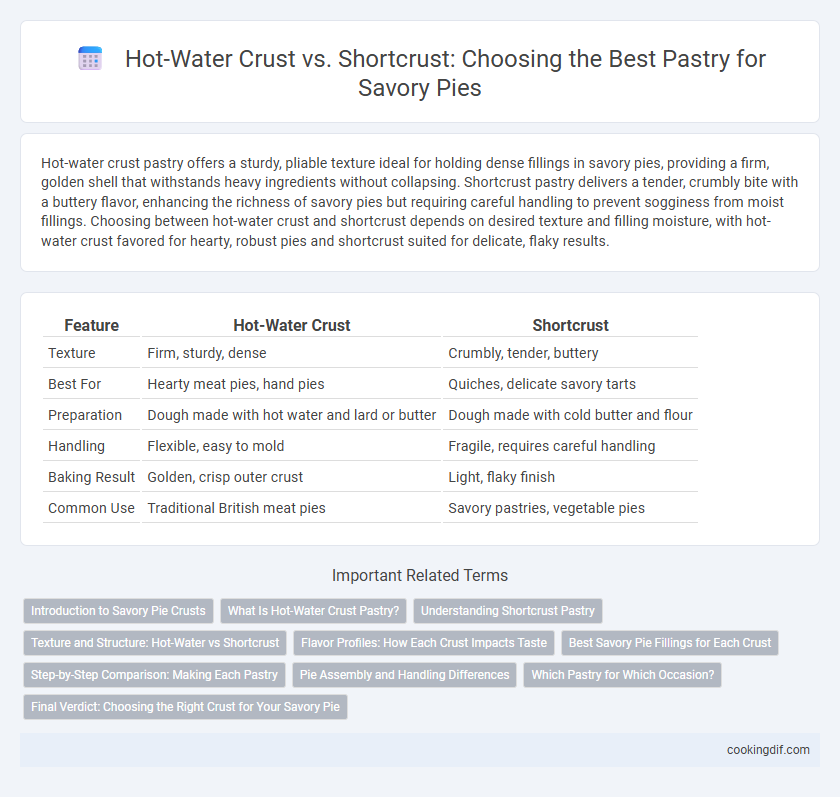Hot-water crust pastry offers a sturdy, pliable texture ideal for holding dense fillings in savory pies, providing a firm, golden shell that withstands heavy ingredients without collapsing. Shortcrust pastry delivers a tender, crumbly bite with a buttery flavor, enhancing the richness of savory pies but requiring careful handling to prevent sogginess from moist fillings. Choosing between hot-water crust and shortcrust depends on desired texture and filling moisture, with hot-water crust favored for hearty, robust pies and shortcrust suited for delicate, flaky results.
Table of Comparison
| Feature | Hot-Water Crust | Shortcrust |
|---|---|---|
| Texture | Firm, sturdy, dense | Crumbly, tender, buttery |
| Best For | Hearty meat pies, hand pies | Quiches, delicate savory tarts |
| Preparation | Dough made with hot water and lard or butter | Dough made with cold butter and flour |
| Handling | Flexible, easy to mold | Fragile, requires careful handling |
| Baking Result | Golden, crisp outer crust | Light, flaky finish |
| Common Use | Traditional British meat pies | Savory pastries, vegetable pies |
Introduction to Savory Pie Crusts
Hot-water crust and shortcrust are popular bases for savory pies, each offering distinct textures and handling qualities. Hot-water crust, made by mixing fat with boiling water, creates a sturdy, pliable dough ideal for hand-raised pies like pork pies. Shortcrust, composed of fat and flour without water, yields a crumbly, tender texture preferred for quiches and meat pies where a delicate crust is desired.
What Is Hot-Water Crust Pastry?
Hot-water crust pastry is a sturdy, pliable dough made by melting fat in boiling water before mixing it with flour, creating a thick, elastic crust ideal for savory pies like pork pies and game pies. Its robust texture holds moist fillings well without becoming soggy, making it preferable over shortcrust for pies requiring a strong structural shell. Unlike the crumbly and buttery shortcrust, hot-water crust pastry offers a denser bite and exceptional shape retention during baking and slicing.
Understanding Shortcrust Pastry
Shortcrust pastry is prized for its tender, crumbly texture achieved by minimal gluten development and high fat content, typically using butter or lard. Its versatility allows it to hold delicate, moist savory fillings without becoming soggy, making it ideal for quiches, meat pies, and vegetable tarts. Unlike hot-water crust, which is denser and more elastic for sturdy hand-held pies, shortcrust offers a rich, flaky base that enhances the overall eating experience in traditional savory pies.
Texture and Structure: Hot-Water vs Shortcrust
Hot-water crust pastry offers a robust, sturdy texture ideal for holding heavy or wet fillings without becoming soggy, making it perfect for traditional British pork pies. Shortcrust pastry provides a crumbly, tender structure with a delicate bite, enhancing the overall eating experience in lighter savory pies like quiches or vegetable tarts. The choice between hot-water and shortcrust directly affects the pie's ability to maintain shape and texture during baking and serving.
Flavor Profiles: How Each Crust Impacts Taste
Hot-water crust delivers a rich, savory base with a slightly dense texture that enhances the meaty fillings of savory pies, providing a hearty and traditional flavor experience. In contrast, shortcrust offers a crumbly, buttery texture that introduces a delicate richness, balancing robust fillings with subtle sweetness and a tender bite. Each crust distinctly influences the overall taste, with hot-water crust emphasizing depth and durability, while shortcrust prioritizes lightness and buttery flavor.
Best Savory Pie Fillings for Each Crust
Hot-water crust suits dense, hearty fillings like pork pies, game meats, and rich stews due to its sturdy, moldable texture that holds shape well during baking. Shortcrust pastry complements lighter, more delicate fillings such as chicken and mushroom, cheese and onion, or vegetable medleys, offering a crisp, crumbly base that enhances mild flavors. Selecting the appropriate crust maximizes the flavor profile and structural integrity of savory pies.
Step-by-Step Comparison: Making Each Pastry
Hot-water crust pastry involves melting lard or butter in boiling water before incorporating flour, creating a pliable dough ideal for hand-formed savory pies like pork pies. Shortcrust pastry combines flour, cold butter, and minimal water, producing a crumbly, tender base perfect for quiches and tarts that require a delicate texture. Hot-water crust requires shaping while warm, allowing sturdy, moldable shells, whereas shortcrust demands careful chilling and minimal handling to prevent toughness and achieve a crisp, flaky finish.
Pie Assembly and Handling Differences
Hot-water crust pastry, made by boiling water and fat before mixing with flour, offers a sturdy and pliable texture ideal for molding into sturdy pie cases that hold heavy fillings without collapsing. Shortcrust pastry is more delicate and crumbly, requiring careful handling during assembly to prevent cracking, often necessitating chilling and gentle rolling to maintain its structure. Hot-water crusts withstand shaping and thick fillings better during baking, while shortcrust pies benefit from blind baking to preserve form and prevent sogginess.
Which Pastry for Which Occasion?
Hot-water crust pastry offers a sturdy, dense texture ideal for hearty, meat-filled pies that require structural integrity, such as pork pies or game pies, making it perfect for picnics or outdoor events. Shortcrust pastry, known for its crisp, crumbly texture, excels with lighter savory fillings like quiches or vegetable tarts, suited for elegant dinners or casual lunches. Choosing between hot-water crust and shortcrust depends on the pie's filling weight and the formality of the occasion.
Final Verdict: Choosing the Right Crust for Your Savory Pie
Hot-water crust offers a sturdy, thick shell ideal for holding heavy fillings like meat and game, preventing sogginess during baking. Shortcrust provides a crumbly, tender texture that enhances lighter fillings such as vegetable or cheese-based pies. Selecting between hot-water crust and shortcrust depends on balancing the filling's weight and desired texture to achieve the perfect savory pie.
Hot-water crust vs shortcrust for savory pies Infographic

 cookingdif.com
cookingdif.com